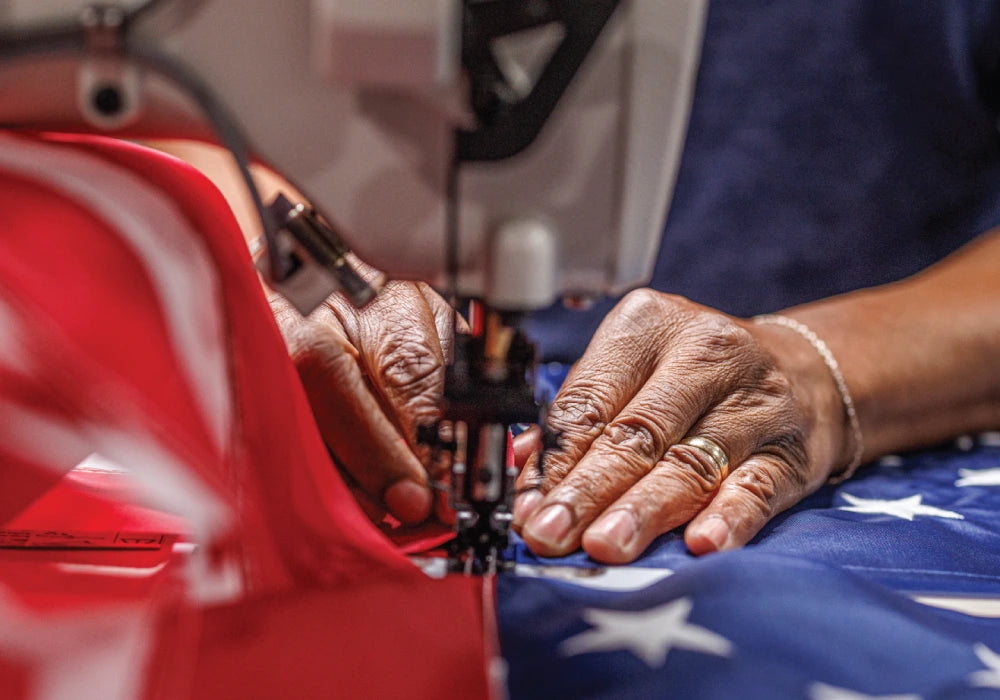In open waters, communication becomes challenging, especially when radio contact is limited or impossible. That’s where nautical signal flags come in. These colorful flags are part of an age-old system that lets vessels share messages using only visual signals. Every flag has a unique meaning and can represent a letter, number, or entire message when combined. Sailors have relied on these flags to express urgent needs or critical alerts. Their bright colors make them easy to spot, even from long distances. These flags remain a vital form of nonverbal communication.
National Flags at Sea: Understanding U.S. Maritime Flags
The United States Maritime Flag (U.S. Ensign)
It designates a vessel's nationality and is required on all U.S.-registered ships. The flag typically features thirteen red and white stripes and a blue field with fifty stars, similar to the national flag flown on land. However, it serves a specialized function when displayed aboard a vessel. The U.S. ensign is usually flown from the stern when the boat is anchored or docked, and from the gaff when underway. Placement matters because it reflects a vessel’s operational status. Ships must raise the ensign promptly at 0800 and lower it at sunset. Respecting its display not only honors tradition but ensures compliance with maritime protocol in both domestic and international waters.
Nautical American Flag vs. Maritime American Flag
The maritime American flag is the formal ensign flown to signal a vessel’s national registry and is governed by strict display rules. In contrast, a nautical American flag often refers to decorative or stylized versions used by civilian boaters, especially during holidays or celebrations. These can include variations with nautical rope details, distressed finishes, or windproof materials. While these decorative flags add flair to vessels, they should not be used in place of the official ensign when operating in regulated waterways. Confusing the two may lead to improper flag etiquette or unintentional disrespect.
The U.S. Boat Flag and Yacht Ensign
The yacht ensign features a fouled anchor surrounded by thirteen stars, symbolizing America’s original colonies and seafaring legacy. Initially designated for documented yachts, it is now commonly used on pleasure craft, particularly when sailing within U.S. waters. Despite its popularity, this ensign is not a replacement for the national flag during international travel. Boaters using the yacht ensign must understand its limitations, especially when crossing into foreign ports where the official maritime ensign is required.
Rules for Displaying a Marine-Grade American Flag on Boats
Displaying an American flag on a boat is a time-honored maritime practice steeped in respect, symbolism, and protocol. The U.S. Ensign is a powerful visual representation of national pride and must be handled with intention and dignity on the water. Here's how:
- Material: The harsh conditions of marine environments demand materials that can endure prolonged exposure to the elements. A proper marine-grade American flag should be constructed from UV-resistant, quick-drying fabrics such as nylon or polyester engineered explicitly for maritime use. These materials are designed to resist fading from sun exposure, withstand high winds without shredding, and repel saltwater to prevent accelerated deterioration. Inferior fabrics, such as those meant for indoor use, will fray quickly, become discolored, or absorb moisture, resulting in a limp and disheveled appearance. Look for flags with reinforced stitching and double-stitched hems, as these details help maintain the flag’s structural integrity even in turbulent conditions.
- Mounting Point: Traditional flag etiquette at sea requires careful attention to where the flag is flown based on the boat’s status. When your vessel is anchored or moored, the U.S. flag should be displayed from the stern. This is the place of honor and has long been recognized as the standard mounting point for an ensign at rest. However, when the ship is underway (i.e., actively moving under power or sail), the correct location shifts to the gaff—an angled spar attached to the mainmast if present. If your boat lacks a gaff, the highest possible point on the aft (rear) superstructure may be used as an alternative.
- Condition: The appearance of your flag speaks volumes about your respect for national symbols. Allowing an American flag to become dirty, faded, torn, or waterlogged dishonors its symbolic importance and detracts from the professional appearance of your vessel. While occasional wear is expected in a marine setting, routine checks should be performed to assess the flag’s condition. If the fabric begins to fray at the edges or lose its vibrant colors, it’s time to retire the flag and replace it with a new one. Ensure the flag is positioned to avoid constant flapping against surfaces or dipping into the water during turns or gusty conditions. If high winds or spray are expected, consider temporarily lowering the flag to protect it from excessive strain.
- Storage: How you store your flag when it’s not being flown is just as important as how you display it. Once removed from its mount, the flag should be carefully inspected for damage or moisture. If damp, allow it to dry completely before storage. Avoid crumpling or stuffing the flag into a compartment. Fold it using the traditional triangle method or roll it neatly to maintain its shape and dignity. Store the flag in a clean, dry, and well-ventilated area free from sharp objects or heavy equipment that could cause accidental damage. Many boaters keep a dedicated drawer, cloth bag, or storage tube onboard specifically for their flags to prevent mishandling. Treating the flag with care during off-duty periods ensures it remains in display-worthy condition.
- Size: Proportion is a key aspect of proper flag display and is often overlooked by casual boaters. A flag that is too large can look overpowering or awkward, while a flag that is too small may appear insignificant or even disrespectful. As a general rule, the flag’s length should be one inch for every foot of the boat’s overall length. For example, a 30-foot boat should fly a flag approximately 30 inches long. The width will be proportional to the standard flag dimensions, typically following the official 1:1.9 aspect ratio of the United States flag. This sizing standard ensures that the flag maintains its intended visual impact without dominating or disappearing from view. Additionally, using a properly scaled flag prevents unnecessary strain on the mounting hardware and minimizes the risk of tangling against structural components.
Each detail contributes to an overall expression of respect and tradition. Observing these practices ensures your flag not only endures the marine elements but also serves its symbolic purpose with honor.
The International Code of Signals Explained
Alphabetic Nautical Code Flags
Each letter in the alphabet has a corresponding symbol in the nautical code flags system, allowing sailors to spell out words or signal specific meanings. These flags follow the International Code of Signals and are paired with a phonetic designation, such as Alpha, Bravo, or Charlie. The purpose of this pairing is to ensure clarity when flags are interpreted visually or relayed verbally over communication channels. For example, the Alpha flag signifies "I have a diver down; keep clear," while the Bravo flag means "I am carrying dangerous cargo." This uniformity helps eliminate confusion among international vessels. Understanding both the visual design and phonetic pronunciation of each flag can be critical when rapid communication is necessary.
Numerical Pennants and Expanded Message Capability
Beyond letters, the International Code of Signals incorporates number-based flags known as numerical pennants. These are essential when conveying information such as coordinates, quantities, or specific reference numbers. Each pennant, numbered 0 to 9, has a distinct design to differentiate it from the others visually. Numerical pennants are often used in conjunction with alphabet flags to create detailed instructions or situational data. For instance, a flag message might indicate a rendezvous point using latitude and longitude, or instruct another vessel to wait for “30 minutes.” By using numbers, mariners can communicate with far more precision.
Two-Flag Combinations for Specific Instructions
Single flags can only convey a limited set of meanings, so the system also includes preset two-flag combinations that deliver concise instructions. These combinations are not random but follow internationally agreed-upon standards. The pairing of "NC" signals “I am in distress and require immediate assistance,” while “BR” might refer to the presence of hazardous conditions. The use of two flags ensures quicker communication of complex needs without having to spell out long words. They’re especially helpful in emergencies, where time is of the essence.
Substitute Pennants and Their Role
To avoid confusion when a flag must be repeated in a sequence, mariners use substitute pennants, which represent a repeated letter without duplicating the same flag. Since only one set of alphabetic flags is typically available on board, the substitute pennants act as placeholders. There are three types: First Substitute, Second Substitute, and Third Substitute, each indicating a specific position in the sequence where a repeat occurs. For example, if a message contains two “A” flags, the second instance would be replaced with the First Substitute pennant. This system enables ships to transmit long or detailed words without requiring duplicate flags, conserving space and simplifying deployment. It’s a clever workaround that keeps messages organized and legible even from a distance. Knowing how to use these pennants effectively is a key skill in interpreting complex nautical flag messages.
Practical Use of Nautical Signal Flags on Vessels
Flag Codes for Ships in Motion and Docked Conditions
When a vessel is in motion, flags are typically displayed higher up, such as on the masthead, to maximize visibility and communicate intentions or status to nearby boats. A pilot flag indicates that a harbor pilot is onboard, while a quarantine flag signals health precautions. When docked or anchored, flags often move to the stern or other designated positions, signaling the vessel’s status or readiness for communication. These codes are crucial for maintaining safety in busy waterways and ensuring that all nearby vessels are aware of each other's movements.
Best Practices for Hoisting, Spacing, and Visibility
Proper hoisting and spacing of the flag for boaters are crucial to ensure that messages are correctly interpreted. Below are the key best practices:
- Select Unobstructed Locations: Ensure flags are raised where rigging, sails, or other equipment do not block visibility.
- Maintain Proper Spacing: Leave enough distance between flags to avoid overlap and confusion.
- Use Correct Height: Raise flags high enough to be seen clearly by other vessels and shore observers.
- Keep Flags Taut: Apply steady tension on halyards to prevent flags from drooping or folding.
- Follow Message Order: Display flags in the proper sequence, with primary signals closest to the masthead.
- Minimize Background Clutter: Avoid hoisting flags against dark or busy backgrounds that reduce contrast.
- Adapt for Lighting Conditions: Use illumination or reflective materials during low-light or nighttime signaling.
- Separate Multiple Messages: Space out simultaneous signals by time or location on different masts.
- Limit Number of Flags: Avoid excessive flags to prevent message clutter and confusion.
- Train Crew Regularly: Practice hoisting and recognizing flags to improve communication accuracy and response.
Implementing these best practices transforms nautical flag usage from a rudimentary display into a reliable communication system.
Using Naval Communication Flags During Radio Silence
Naval vessels often observe periods of radio silence to maintain stealth or avoid interference, making naval communication flags invaluable. During these times, ships rely entirely on visual signals to share commands. The standardized flag system ensures that every crew understands the signals, regardless of language differences. Even non-naval ships may observe radio silence during emergencies.
Cultural and Recreational Use of Maritime Flag Symbols
The Diver Down Flag and Yellow Quarantine Flag
Certain maritime flag symbols carry legal significance and require careful adherence to regulations. The Diver Down flag, characterized by a red field with a white diagonal stripe, alerts other vessels to the presence of divers underwater. This flag is a crucial safety tool and must be displayed whenever diving activities occur nearby. Local laws often dictate minimum distances that other boats must maintain to protect divers from harm. Similarly, the Yellow Quarantine flag indicates that a vessel is under health restrictions, typically due to contagious illnesses on board. International maritime law mandates its use in specific quarantine situations, signaling that entry or contact should be avoided until clearance is granted. Both serve as important legal notices that help maintain order in maritime spaces.
When Not to Use Nautical Flags
Recreational boaters should be mindful of flag etiquette to avoid miscommunication or unintentional offense. Certain boat communication flags carry meanings that are reserved for specific situations or official vessels. Flying a distress flag without cause can provoke unnecessary alarm and is strongly discouraged. Likewise, flags that signify pilotage or customs clearance should not be displayed by non-authorized vessels. The improper use of signal flags can confuse other boaters, potentially leading to dangerous misunderstandings.
Patriotic Boat Accessories
Displaying a patriotic boat accessories collection often includes carefully chosen flags that express pride and identity on the water. Boaters select from options like the maritime American flag, yacht ensigns, and even smaller decorative versions to personalize their vessels. Many boaters invest in high-quality, weatherproof versions made from marine-grade fabrics to ensure durability during long seasons on the water.
Mastering the art of interpreting nautical signal flags empowers boaters with a valuable skill set that enhances safety and communication. Each flag, symbol, and combination carries a clear message. Knowing these meanings boosts confidence when navigating complex maritime situations. Well-informed flag use fosters mutual understanding among vessels, reducing risks. This knowledge also honors a rich naval legacy that connects modern sailors with centuries of seafaring tradition.






